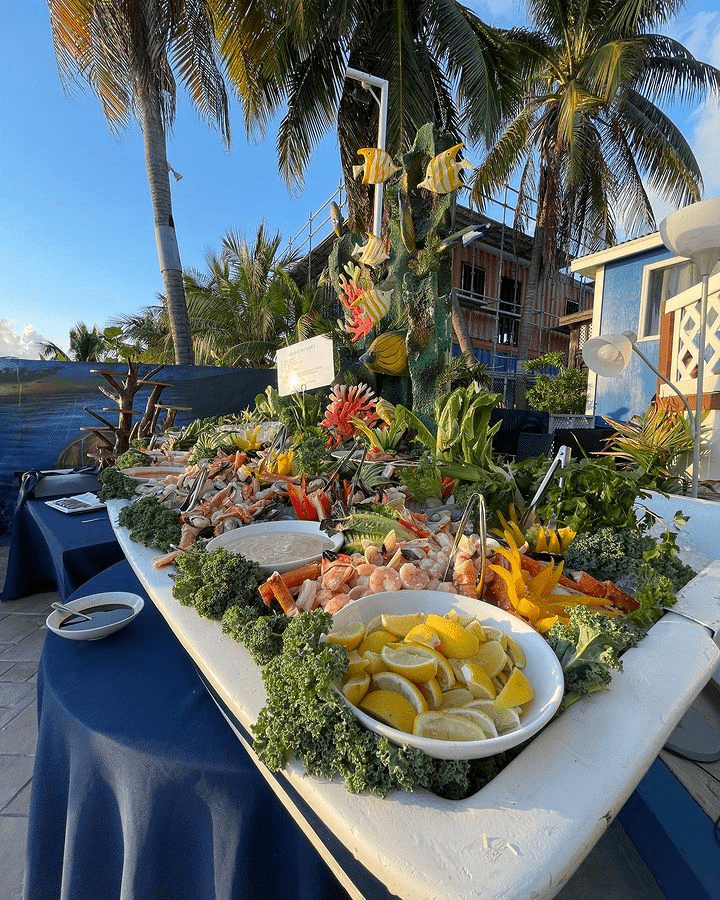

Every destination around the world flaunts its distinctive cultural and local specialties. Let’s set our gaze on the homeland of Pizza and Pasta, Italy. Meanwhile, Japan sings praises of its fresh & diverse Sushi options and, of course, not to forget the recent global sensation, Ramen! Turning our heads to India, the country stands tall with its flavorful and wholesome Hyderabadi Biryani and, thin, crispy, and loaded with potato stuffing Dosa.
On the other side of the globe, the United States gracefully boasts about the smoked, spicy, and saucy Barbecue alongside soft yet crunchy Cheesestake, and France proudly showcases the mastery with its buttery and flaky Croissants and soul-nourishing, loaded with vegetables, Ratatouille.
While these nations reflect their pride, heritage, culture, and culinary traditions, one Caribbean gem always steals the spotlight with its vibrant and exotic flavors and local delights. Yes, you guessed it right, we are talking Cayman, a bustling holiday destination and hub of countless lip-smacking gastronomic delicacies.
Ready to join us on a journey of epicurean bliss? Walk with us as we transport you to every foodie’s paradise.

Cayman, in particular Grand Cayman, walks tall with a variety of mouth drooling dishes, which can be discovered in local seafood restaurants, beachfront eateries, food trucks, and numerous upscale restaurants in Cayman.
Let us give you a glimpse of must eats in Grand Cayman
Wondering what to eat in the Cayman Islands, immerse yourself in every islander's choice: Conch Fritters. The roots of the dish go deep into Caribbean cuisine. Besides Cayman, Conch also recognized as ‘Konk,’ is believed to be a star ingredient among Bahamians. For readers unfamiliar with Conch, it is a sea snail discovered in the warm embrace of the Caribbean Sea. Many consider that the dish has been a legacy left by indigenous people as they were the ones who caught it fresh and used it as a food source until Europeans arrived.
Today, Conch Fritters is ruling over the hearts of Caymanians as well as numerous other renowned regions, including Florida and the Gulf Coast. In fact, travelers especially visit the Grand Cayman to indulge in this island's goodness.
As far as the preparation is concerned, Conch Fritters can be cooked in a variety of ways. Every region adds its touch of variation and sprinkles secret ingredients to tune it with its culture.
Although the most common method of cooking this juicy and flavorsome meal is by tenderizing or grounding the fresh Conch and marinating it with a batter of flour, eggs, milk, and authentic aromatics and ingredients, which includes garlic powder, onion powder, thyme, and hot peppers, the coated Conch is fried until golden and crispy and served with a side of spicy mayonnaise or citrus infused dip.
Once upon a time, Turtle Stew was an icon of Cayman, the Southern United States, and a few parts of Asia. Although the cooking and relishing of the stew has been now forbidden in all the regions due to conservation practices, this warm and meaty dish has forever etched a place in the hearts of its enthusiasts.
Turtle Stew shares a long history and is trusted to have originated from indigenous people because Turtles were the most practical and bountiful resource that complemented the majority of ingredients. Moreover, Native American Tribes and European settlers included this wholesome stew in their diet thanks to the plenty of protein they got in a single serving, which kept them full throughout the day.
The flavors of Turtle Stew are rich but may vary according to regional preferences. Apart from the succulent turtle meat, other common ingredients featuring fresh vegetables such as tomatoes, bell peppers, onions, garlic, thyme, bay leaves, and hot peppers are slow-cooked with traditional seasonings until the meat is soft enough to melt in your mouth.
From Mahi Mahi to Snapper to Wahoo, Cayman beams with pride for its wealthy and diverse seafood selection. Although, Jerk Chicken, the vanity of Jamaica, has kindled its love among Caymanians and become the best food to eat in Grand Cayman. The history of Jerk Chicken dates back to Maroons, who were African slaves carried to Jamaica by the Spanish. After the invasion of the British in the 17th Century, a few Maroons escaped to the mountains and conserved and cooked the meat for survival.
Years later, the dish was cherished not only by Jamaicans but also by Caymanians and other international locations because of its immaculate flavors that linger on the taste buds long after diners savor this epicurean bliss. The dish has a plethora of ingredients, including Scotch Bonnet Peppers, Pimento, Thyme, Scallions, Garlic, Ginger, and Soy Sauce, which are marinated with Jerk Chicken until the meat soaks all the juice and then simmered over a grill or open flame to serve a dish that transcends an experience beyond ordinary.
Fancy a tipple? Then, Mudslide will lead at the top of your favorite elixirs. It is a classic creamy and strong concoction that Tom Norris, a famous bartender at the Wreck Bar in the Rum Point, mixed to perfection in the 1970s. Over the years, this dessert-style cocktail became a must after localities and travelers gobbled Grand Cayman food.
Originally, Mudslide included 1 oz of Vodka, 1 oz of Coffee, and 1 oz of Irish Cream Liqueur, which are shaken well with ice cubes and strained in a glass. Finally, the drink is garnished with whipped cream or a generous drizzle of chocolate syrup. However, different bartenders customized the drink according to their unique tastes and preferences.
This traditional dessert, widely recalled as Yuca or Manioc, stems from the Philippines, which refers to a starchy root vegetable inherited from South America but equally cultivated in tropical regions.
Cassava is used for several meals, including desserts like cassava cake. For many years, Cassava Cake took center stage in countless festivities and occasions in the Philippines. Although, years later, this decadent indulgence broke all geographical boundaries and became a beloved dessert among South Asians.
Preparing the cake is as easy as taking a walk in the park. All you need is to blend grated cassava with coconut milk, condensed milk, sugar, eggs, and butter, and bake it until a moist, warm, and gooey surprise comes out for you to take a bite. Many pastry chefs top it off with shredded cheese, desiccated coconut, or infused vanilla or pandan extracts.
Local cuisine and flavors are a fantastic way to reflect the unique culture and heritage of a community, and we are proud to represent and serve an experience of our native masterpieces at The Wharf. With each dish, we aim to exhibit regional specialties and our commitment to offering impeccable services and mesmerizing ambience.
We invite you to submerge in a tale of tradition, passion, and profound connection with our local delicacies at Cayman's most prestigious fine dining restaurant.